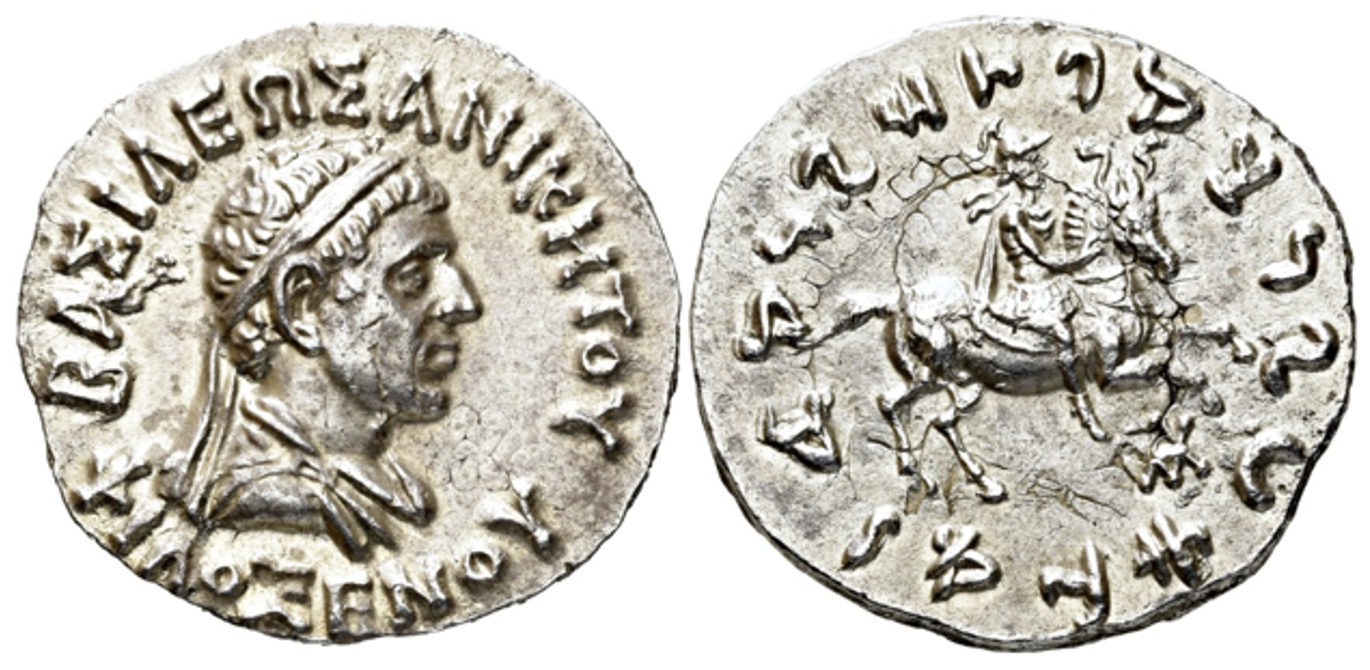125 BCE - 110 BCEBAΣIΛEΩΣ ANIKHTΟΥ ΦIΛOΞENOY | Maharasha apadihatasa Philasinasa (of Great King Philoxenos the Unconquered)
Overstriking coin
SO 2066.png
|
|
Sale(s)Sale(s) ᵖ:
|
Gorny & Mosch 269 (09/03/2020), lot 646 ; Heritage, Signature Auction 3054 (07/04/2017), lot 30169 ; Gorny & Mosch 249 (11/10/2017), lot 366
|
|
|
|
Description
| ObverseInscription or printing placed on the obverse.:
|
BAΣIΛEΩΣ ANIKHTΟΥ ΦIΛOΞENOY (Greek) diademed, draped and cuirassed bust of Philoxenus right
|
ReverseInscription or printing placed on the reverse.:
|
Maharasha apadihatasa Philasinasa (of Great King Philoxenos the Unconquered) (Kharoshthi) Philoxenus in cavalry armor galloping right on horseback, holding couched spear, monogram below.
|
Mint and issuing power
Chronology
| FromIdentifies the initial date in a range assigned in a numismatic context. 125 BCE toIdentifies the final date in a range assigned in a numismatic context.. 110 BCE
|
Hellenistic 323-30 BC  periodTime period of the numismatic object. periodTime period of the numismatic object.
|
Physical description
MetalThe physical material (usually metal) from which an object is made.: Silver 
|
WeightWeight of the numismatic object (in grams). in grams: 9.699.69 g <br />9,690 mg <br />
|
DenominationTerm indicating the value of a numismatic object. Examples: tetradrachm, chalkous, denarius.: tetradrachm 
|
AxisDescribes the directional relationship between the obverse and reverse of a numismatic object.: 1212 mm <br />1.2 cm <br />
|
| DiameterDescribes diameter of an object (in mm).: 2828 mm <br />2.8 cm <br />
|
StandardStandard.: Indian
|
References
Description
| ObverseInscription or printing placed on the obverse.:
|
visible on obverse: monogram
|
ReverseInscription or printing placed on the reverse.:
|
visible on reverse: head right
|
Mint and issuing power
| MintIdentifies the place of manufacture or issue of a numismatic object. ᵖ:
|
|
Ancient regionAncient region. ᵖ
|
|
Modern countryModern country:
|
AuthorityIdentifies the authority in whose name (explicitly or implicitly) a numismatic object was issued. ᵖ:
|
|
Chronology
| FromIdentifies the initial date in a range assigned in a numismatic context. toIdentifies the final date in a range assigned in a numismatic context..
|
periodTime period of the numismatic object.
|
Physical description
References
References
- ^ Bopearachchi, Osmund (1991), Monnaies gréco-bactriennes et indo-grecques : catalogue raissoné, Paris, 459 p., 69 pl.
- ^ Mitchiner, Michael (1975), Indo-Greek and Indo-Scythian coinage, London,
- ^ Hoover, Oliver D. (2013), Handbook of coins of Baktria and ancient India : including Sogdiana, Margiana, Areia, and the Indo-Greek, Indo-Skythian, and native Indian states south of the Hindu Kush, fifth century BC to first century, Lancaster-London,
